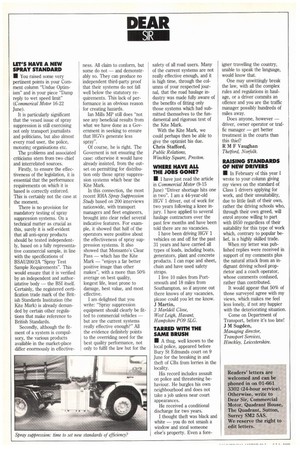LET'S HAVE A NEW SPRAY STANDARD MI You raised some
Page 30

If you've noticed an error in this article please click here to report it so we can fix it.
very pertinent points in your Comment column "Undue Optimism" and in your piece "Damp reply to wet speed limit" (Commerical Motor 16-22 June).
It is particularly significant that the vexed issue of spray suppression is still exercising not only transport journalists and politicians, but also almost every road user, the police, motoring organisations etc.
The problems and associated criticisms stern from two chief and interrelated sources.
Firstly, to ensure the effectiveness of the legislation, it is essential that the performance requirements on which it is based is correctly enforced. This is certainly not the case at the moment.
There is no provision for mandatory testing of spray suppression systems. On a technical matter as crucial as this, surely it is self-evident that all anti-spray products should be tested independently, based on a fully representative commercial sample, in line with the specifications of BSAU200/2A "Spray Test Sample Requirements". This would ensure that it is verified by an independent and authoriatative body — the BSI itself. Certainly, the registered certification trade mark of the British Standards Institution (the Kite Mark) is already demanded by certain other regulations that make reference to British Standards.
Secondly, although the fitment of a system is compulsory, the various products available in the market-place differ enormously in effective
ness. All claim to conform, but some do not — and demonstrably so. They can produce no independent third-party proof that their systems do not fall well below the statutory requirements. This lack of performance is an obvious reason for creating hazards.
Ian Mills MP still does "not see any beneficial results from what we have done as a Government in seeking to ensure that HGVs generate less spray".
Of course, he is right. The Govement is not ensuring the case: otherwise it would have already insisted, from the outset on permitting for distribution only those spray suppression systems which bear the Kite Mark.
In this connection, the most recent RHA Spray Suppression Study based on 200 interviews nationwide, with transport managers and fleet engineers, brought into clear relief several indicative features. For example, it showed that half of the operators were positive about the effectiveness of spray suppression systems. It also showed that Monsanto's Clear Pass — which has the Kite Mark — "enjoys a far better positive image than other makes", with a more than 50% average on best quality, longest life, least prone to damage, best value, and most effective.
I am delighted that you write: "Spray suppression equipment should clearly be fitted to commercial vehicles — but are the current systems really effective enough?" All the evidence definitely points to the overriding need for the best quality performance, not only to fulfil the law but for the safety of all road users. Many of the current systems are not really effective enough, and it is high time, through the columns of your respected journal, that the road haulage industry was made fully aware of the benefits of fitting only those systems which had submitted themselves to the fundamental and rigorous test of the Kite Mark.
With the Kite Mark, we could perhaps then be able to give the optimist his due. Chris Stafford, Public Relations, Winckley Square, Preston.
































































































